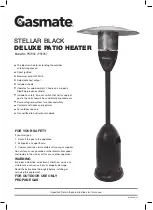
INSTALLATION
25
You must be able to read the information on the rating plate. If possible leave headroom of one water heater
height so the anode can be inspected or replaced. Remember you may have to take the entire water heater
out later for servicing. Remember all local authorities have regulations about putting water heaters into roof
spaces.
The water heater is to be installed at ground or floor level and must stand vertically upright on a stable base
as acceptable to local authorities. The base of the water heater is made of corrosion resistant material, and it
may be placed directly in contact with the supporting surface. It is not necessary to allow for free air circulation
under the base of the water heater.
Note:
The water heater should not be placed in direct contact with a concrete surface that is less than two
months old and not fully cured as this may attack the metal coating of the water heater base. A moisture barrier
should be used between the two surfaces in this instance.
SAFE TRAY
Where damage to property can occur in the event of the water heater
leaking, the water heater must be installed in a safe tray. Construction,
installation and draining of a safe tray must comply with AS/NZS 3500.4 and
all local codes and regulatory authority requirements. AS/NZS 3500.4 also
has particular requirements when a safe tray must be installed.
MAINS WATER SUPPLY
Where the mains water supply pressure exceeds that shown in the table below, an approved pressure limiting
valve is required and should be fitted as shown in the
on page 31.
Model
250, 315
Temperature pressure relief valve setting
1000 kPa
Expansion control valve setting*
850 kPa
Maximum mains supply pressure
With expansion control valve
680 kPa
Without expansion control valve
800 kPa
* Expansion control valve not supplied with water heater
TANK WATER SUPPLY
If the water heater is supplied with water from a tank supply and a pressure pump system is not installed, then
the bottom of the supply tank must be at least 1 m above the highest point of the hot water plumbing system,
including the water heater. Care must be taken to avoid air locks. The cold water line to the water heater should
be adequately sized and fitted with a full flow gate valve or ball valve.
ANODE
The vitreous enamel lined cylinder of the water heater is only covered by the Solahart warranty when the total
dissolved solids (TDS) content in the water is less than 2500 mg/L and when the correct colour coded anode
is used. If an incorrect colour coded anode is used in the water heater, any resultant faults will not be covered
by the Solahart warranty. In addition, the use of an incorrect colour coded anode may shorten the life of the
water heater cylinder.
The correct colour coded anode for the water supply being used must be selected and fitted to the water heater
for the Solahart warranty to apply to the water heater cylinder (refer to
on page 18 and the
on page 18). The black anode is typically fitted as standard.
If an incorrect anode is used, there is also the possibility the anode may become overactive and hydrogen gas
could accumulate in the top of the water heater during long periods of no use. In areas where this is likely to
occur, the installer should instruct the householder on how to dissipate the gas safely (refer to
page 19).
REDUCING HEAT LOSSES
The cold water line to and the hot water line from the water heater must be insulated in accordance with the
requirements of AS/NZS 3500.4. The insulation must be weatherproof and UV resistant if exposed.
















































